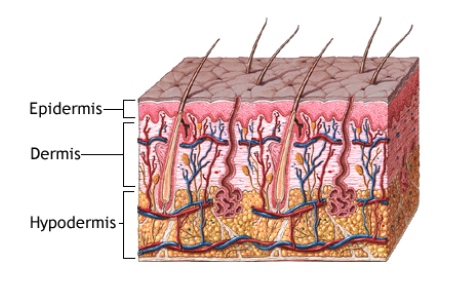Introduction
Our skin is the largest organ of the body that plays many important roles. It acts as a barrier protecting the body against extreme temperatures, harsh sunlight, harmful chemicals and infectious agents. It helps regulate body temperature, moisture, and aids in the production of calcium that is incorporated into our bones by absorbing vitamin D.
It is composed of 3 layers: the epidermis, dermis and hypodermis:
 The epidermis is the outer most layer of the skin that does not contain any blood vessels, which is why you will not bleed if you have a superficial cut of the skin. It does however contain numerous specialized cells that regenerate new cells when damaged, cells that fight against bacteria, and cells that produce pigment known as melanin that help protect against harmful UV light.
The epidermis is the outer most layer of the skin that does not contain any blood vessels, which is why you will not bleed if you have a superficial cut of the skin. It does however contain numerous specialized cells that regenerate new cells when damaged, cells that fight against bacteria, and cells that produce pigment known as melanin that help protect against harmful UV light.
The dermis is the next layer beneath the epidermis that is packed with blood vessels that help carry nutrients, lymph vessels that contain infection-fighting cells, hair follicles and sweat glands that play an important role in regulating body temperature, sebaceous glands that secrete an oil waterproofing the skin and preventing the growth of bacteria or fungi and nerve endings that allow us to sense pain, touch pressure and temperature.
The hypodermis is the thickest layer and contains mostly fat for insulating the body providing protection and padding.
When our skin becomes injured or damaged the body’s primary protection barrier is disrupted and adequate care must be taken to restore it to its normal state.


